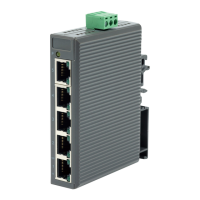- 10 -
Switching and Address Learning
The EtherDevice switch has an address table that can hold up to 1K node
addresses, making it suitable for use with large networks. The address tables
are self-learning, so that as nodes are added or removed, or moved from one
segment to another, the switch automatically adds new node locations to the
tables. An address-aging algorithm causes the least-used addresses to be
deleted in favor of newer, more frequently used addresses. To reset the address
buffer, power down the unit and then power it back up.
Auto-Negotiation and Speed Sensing
All of the switch’s RJ45 Ethernet ports independently support auto-negotiation
for speeds in the 10BaseT and 100BaseTX modes, with operation according to
the IEEE 802.3u standard. This means that some nodes could be operating at
10 Mbps, while at the same time, other nodes are operating at 100 Mbps.
Auto-negotiation takes place when an RJ45 cable connection is made, and then
each time a LINK is enabled. The EtherDevice switch advertises its capability
for using either 10 Mbps or 100 Mbps transmission speeds, with the device at
the other end of the cable expected to similarly advertise. The two devices will
agree to operate at either 10 Mbps or 100 Mbps.
If a EtherDevice switch’s RJ45 Ethernet port is connected to a non-negotiating
device, it will default to 10 Mbps speed and half-duplex mode, as required by
the IEEE 802.3u standard.
Specifications
Technology

